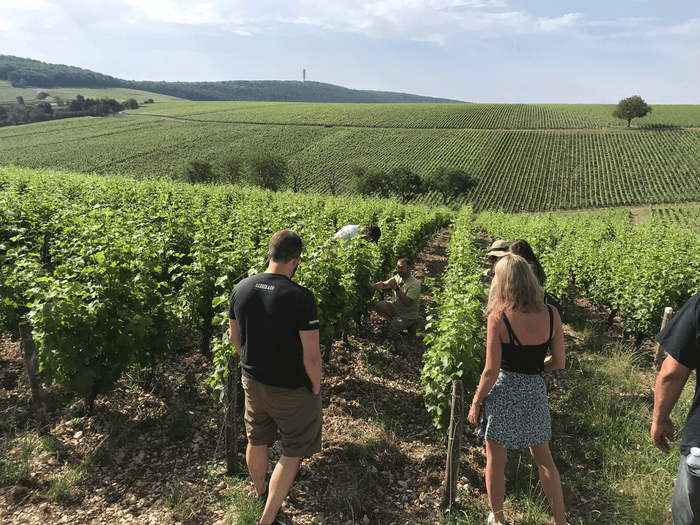
Francois Le Saint, Sancerre
Established in 1749 in the heart of Sancerre, Domaine Fouassier is one of the oldest wine growing families in the Loire Valley with a history that spans several generations. For centuries they have dedicated themselves to preserving and capturing the terroir and the noble Sauvignon grape varietal through an extensive range of appellation wines.
The Fouassier family’s rich winemaking history included Jules Fouassier, a very influential grape grower during the Phylloxera epidemic of the late 19th century. He was the first to utilize copper and sulphur on vines to combat disease, and also single-handedly planted the famous Clos Paradis vineyard in 1902. Jules eldest son, Gustave, won fame by participating in and winning a wine competition in Paris during the summer of 1923. At that time, the rest of France was unfamiliar with the wines of Sancerre, so this victory proved invaluable for showcasing the potential of the region. The newer parts of the winery were built in 1972 when the old cellars – dating back to the 16th century – became too small to accommodate expanding estate holdings. That same year, the Domaine changed their philosophy concerning the vinification process, as they strived to combine the best traditional practices with more modern techniques.
The new century began with the arrival of Fouassier’s 10th generation, Benoit and Paul. In continuing to honor the terroir as their ancestors did, the brothers took things one step further, converting to organic and biodynamic farming and winemaking. In 2011, they were certified by ECOCERT and BIODYVIN, both of whom recognized Domaine Fouassier as 100% compliant with all international organic and biodynamic guidelines.
Today, the estate is comprised of nearly 56 hectares, 80% of which are planted to Sauvignon Blanc and 20% to Pinot Noir, making them the largest landholders in the appellation. The vines range in age from 10-50 years. Planted across varying elevations spanning 150-300 meters above sea level, they primarily enjoy southeastern exposures. Extremely complex soils vary from vineyard to vineyard, some with a high concentration of limestone and deep layers of calcareous clay or Kimmeridgian marl, and some flinty with stones and layers of compacted chalk that contribute to the famous minerality found in the white wines from the region.
Aggressive pruning is carried out multiples times throughout the year to help keep yields low and ensure that only the finest fruit remains on the vine. The grapes are mechanically harvested at their peak between mid September and early October, depending on the vineyard, allowing them to work quickly and capture the fruit at its peak.
State-of-the-art machinery is utilized throughout the winemaking process, but tradition is not forgotten. Upon reception at the winery, the grapes are gently pressed using a pneumatic press. The free-run juice is transferred to stainless steel tanks by use of gravity to undergo fermentation using only ambient and natural yeasts from the vineyard. The white wines are briefly aged on fine lees to add complexity, while the reds spend a fair amount of time in French oak barrels. In keeping with tradition, all work done in the cellar is based on the lunar calendar.
The Fouassier family’s rich winemaking history included Jules Fouassier, a very influential grape grower during the Phylloxera epidemic of the late 19th century. He was the first to utilize copper and sulphur on vines to combat disease, and also single-handedly planted the famous Clos Paradis vineyard in 1902. Jules eldest son, Gustave, won fame by participating in and winning a wine competition in Paris during the summer of 1923. At that time, the rest of France was unfamiliar with the wines of Sancerre, so this victory proved invaluable for showcasing the potential of the region. The newer parts of the winery were built in 1972 when the old cellars – dating back to the 16th century – became too small to accommodate expanding estate holdings. That same year, the Domaine changed their philosophy concerning the vinification process, as they strived to combine the best traditional practices with more modern techniques.
The new century began with the arrival of Fouassier’s 10th generation, Benoit and Paul. In continuing to honor the terroir as their ancestors did, the brothers took things one step further, converting to organic and biodynamic farming and winemaking. In 2011, they were certified by ECOCERT and BIODYVIN, both of whom recognized Domaine Fouassier as 100% compliant with all international organic and biodynamic guidelines.
Today, the estate is comprised of nearly 56 hectares, 80% of which are planted to Sauvignon Blanc and 20% to Pinot Noir, making them the largest landholders in the appellation. The vines range in age from 10-50 years. Planted across varying elevations spanning 150-300 meters above sea level, they primarily enjoy southeastern exposures. Extremely complex soils vary from vineyard to vineyard, some with a high concentration of limestone and deep layers of calcareous clay or Kimmeridgian marl, and some flinty with stones and layers of compacted chalk that contribute to the famous minerality found in the white wines from the region.
Aggressive pruning is carried out multiples times throughout the year to help keep yields low and ensure that only the finest fruit remains on the vine. The grapes are mechanically harvested at their peak between mid September and early October, depending on the vineyard, allowing them to work quickly and capture the fruit at its peak.
State-of-the-art machinery is utilized throughout the winemaking process, but tradition is not forgotten. Upon reception at the winery, the grapes are gently pressed using a pneumatic press. The free-run juice is transferred to stainless steel tanks by use of gravity to undergo fermentation using only ambient and natural yeasts from the vineyard. The white wines are briefly aged on fine lees to add complexity, while the reds spend a fair amount of time in French oak barrels. In keeping with tradition, all work done in the cellar is based on the lunar calendar.

